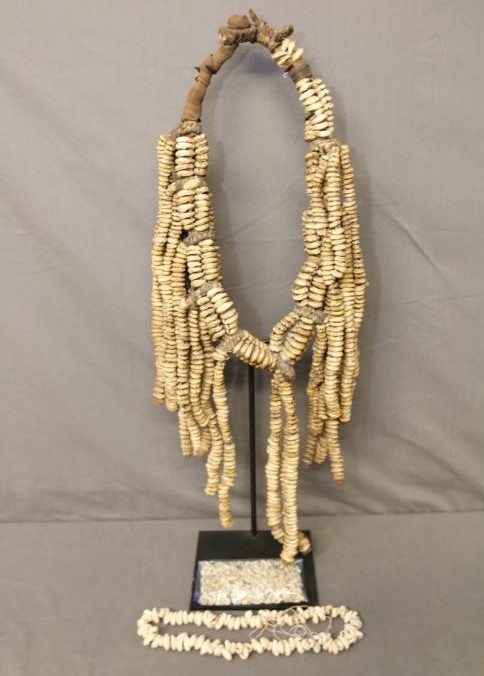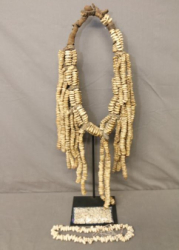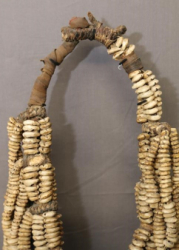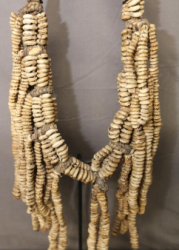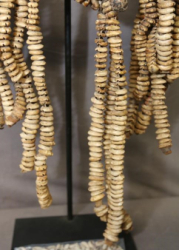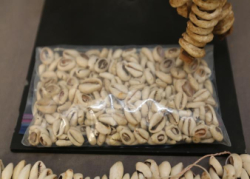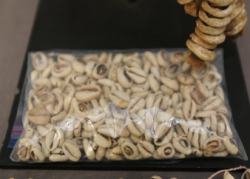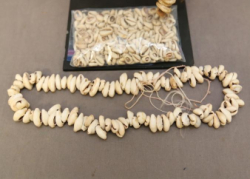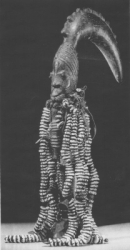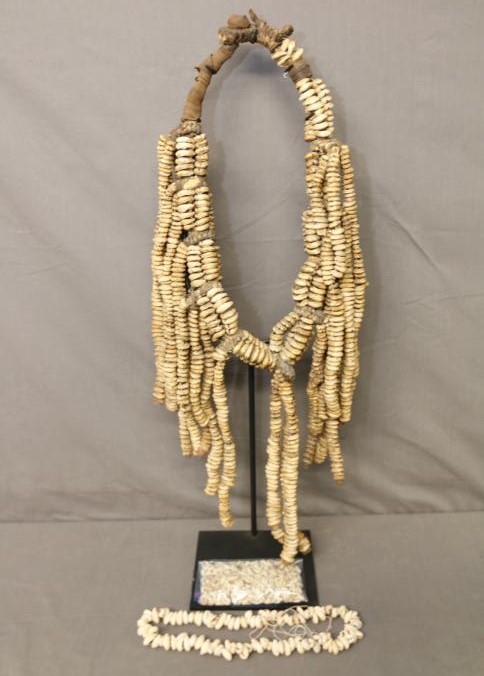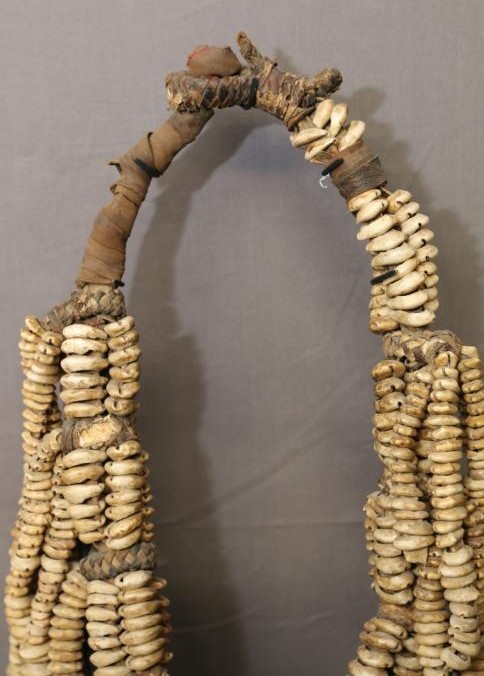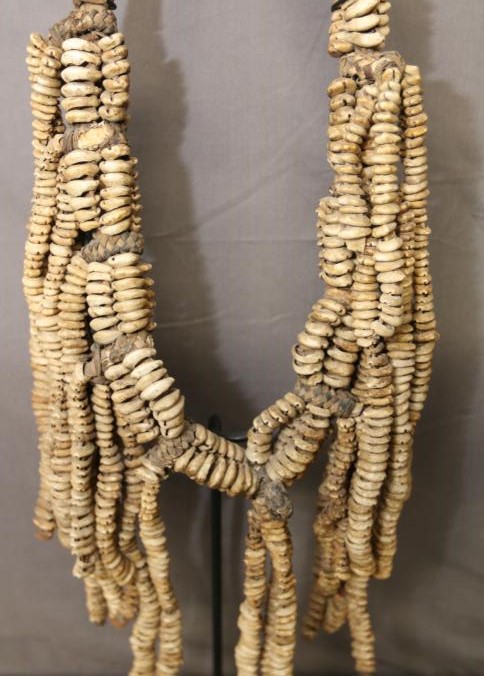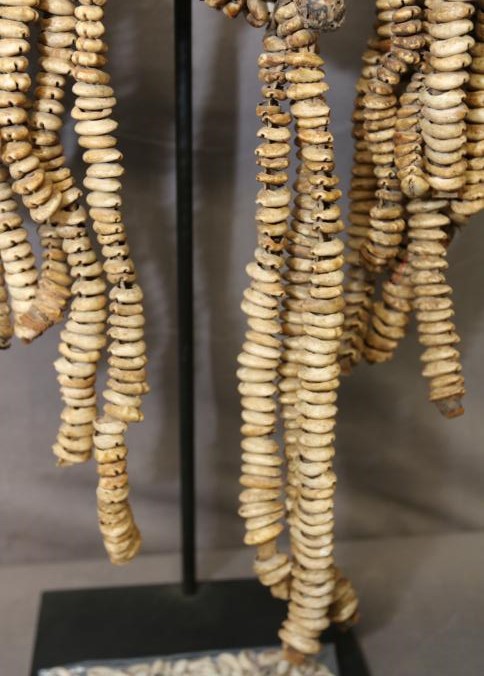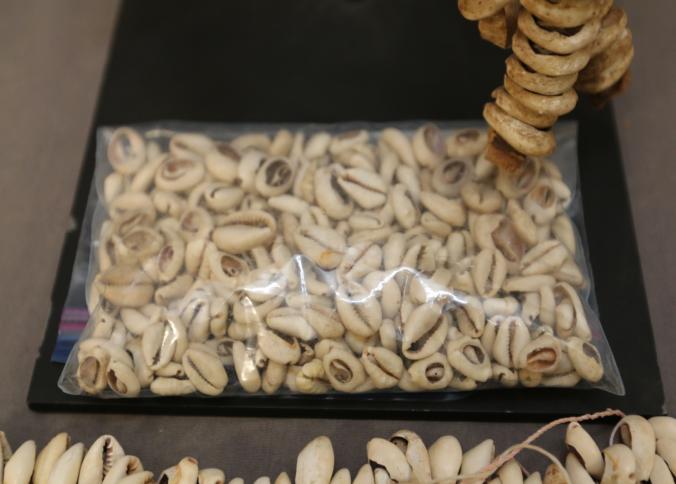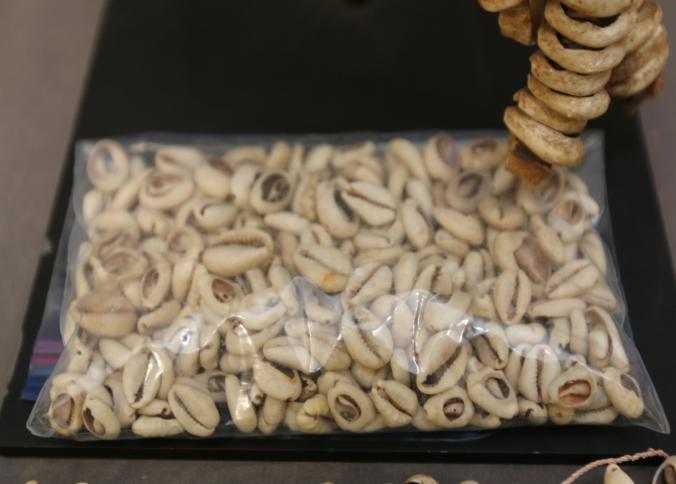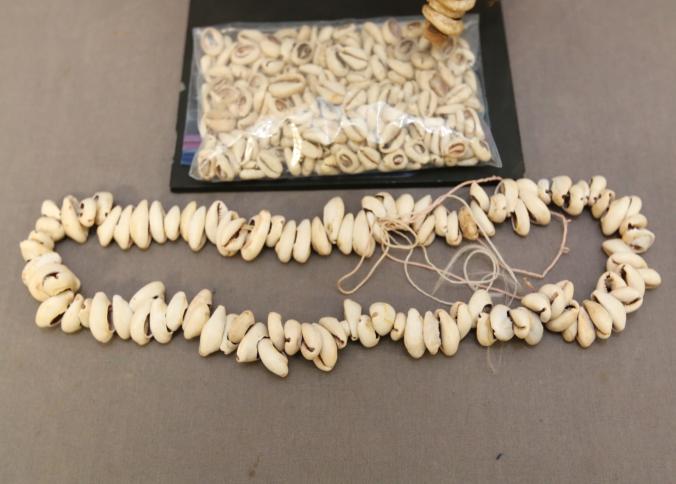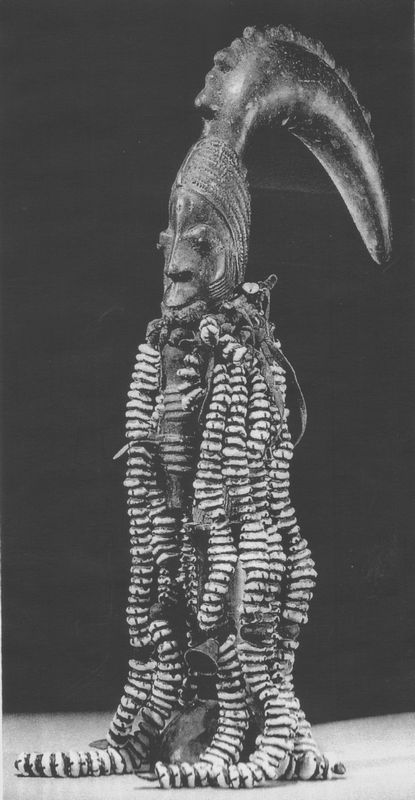Items located in Pleasant Valley, NY. Items include Asafo militia flag - Fante people, Ghana; two slashing knives - Mongo people; man's mourning robe - Ashante people, Ghana; standing Minserah figure; ceremonial chief's necklace - Bamum people, Cameroon' bust of queen - Yoruba people, Benin; wedding blanket - Tuareg people, Niger & Mali; West African bells; old miniature rattle - Chamba people, Cameroon & Nigeria; hexagonal iron sheet currency - Boubi people, Equatorial Guinea and more.
AFRICAN ART COLLECTION OF MARY SUE AND PAUL PETER ROSEN
Mary Sue and Paul Peter Rosen have collected African art for over thirty years, making nine trips to Africa to study the art in its cultural setting. The Rosens have published three African art books, curated more than ten exhibitions from their collection, and have given public lectures about African art and culture. They have donated art from their collection to various institutions including the Newark Museum, Temple University in Philadelphia, the SMA Fathers African Art Museum in Tenafly, New Jersey, and the African American Research Library in Fort Lauderdale, Florida.
Payment is due by Wednesday, November 28 at 1PM.
Pickup in Pleasant Valley, NY must be completed by Wednesday, November 28 at 3PM.
All lots sold as is, where is. There is a 15% Buyers Premium for all lots purchased. Payment methods include cash, MC, Visa, Discover or good check. You can make credit card payment online by going to your Member Area and selecting your invoice.
*NOTE* Shipping is available on all items.
AFRICAN ART COLLECTION OF MARY SUE AND PAUL PETER ROSEN
Mary Sue and Paul Peter Rosen have collected African art for over thirty years, making nine trips to Africa to study the art in its cultural setting. The Rosens have published three African art books, curated more than ten exhibitions from their collection, and have given public lectures about African art and culture. They have donated art from their collection to various institutions including the Newark Museum, Temple University in Philadelphia, the SMA Fathers African Art Museum in Tenafly, New Jersey, and the African American Research Library in Fort Lauderdale, Florida.
Payment is due by Wednesday, November 28 at 1PM.
Pickup in Pleasant Valley, NY must be completed by Wednesday, November 28 at 3PM.
All lots sold as is, where is. There is a 15% Buyers Premium for all lots purchased. Payment methods include cash, MC, Visa, Discover or good check. You can make credit card payment online by going to your Member Area and selecting your invoice.
*NOTE* Shipping is available on all items.
THE FOLLOWING REFERENCES ARE CITED BY AUTHOR NAME AND PUBLICATION DATE IN VARIOUS LOTS:
MS ROSEN/PP ROSEN MASKS FROM WEST AND CENTRAL AFRICA 2013 MS ROSEN/PP ROSEN EMBLEMS OF POWER: ASAFO FLAGS FROM GHANA 2013 (See Lots #7 & 17).
Auction Info
Items located in Pleasant Valley, NY. Items include Asafo militia flag - Fante people, Ghana; two slashing knives - Mongo people; man's mourning robe - Ashante people, Ghana; standing Minserah figure; ceremonial chief's necklace - Bamum people, Cameroon' bust of queen - Yoruba people, Benin; wedding blanket - Tuareg people, Niger & Mali; West African bells; old miniature rattle - Chamba people, Cameroon & Nigeria; hexagonal iron sheet currency - Boubi people, Equatorial Guinea and more.
AFRICAN ART COLLECTION OF MARY SUE AND PAUL PETER ROSEN
Mary Sue and Paul Peter Rosen have collected African art for over thirty years, making nine trips to Africa to study the art in its cultural setting. The Rosens have published three African art books, curated more than ten exhibitions from their collection, and have given public lectures about African art and culture. They have donated art from their collection to various institutions including the Newark Museum, Temple University in Philadelphia, the SMA Fathers African Art Museum in Tenafly, New Jersey, and the African American Research Library in Fort Lauderdale, Florida.
Payment is due by Wednesday, November 28 at 1PM.
Pickup in Pleasant Valley, NY must be completed by Wednesday, November 28 at 3PM.
All lots sold as is, where is. There is a 15% Buyers Premium for all lots purchased. Payment methods include cash, MC, Visa, Discover or good check. You can make credit card payment online by going to your Member Area and selecting your invoice.
*NOTE* Shipping is available on all items.
AFRICAN ART COLLECTION OF MARY SUE AND PAUL PETER ROSEN
Mary Sue and Paul Peter Rosen have collected African art for over thirty years, making nine trips to Africa to study the art in its cultural setting. The Rosens have published three African art books, curated more than ten exhibitions from their collection, and have given public lectures about African art and culture. They have donated art from their collection to various institutions including the Newark Museum, Temple University in Philadelphia, the SMA Fathers African Art Museum in Tenafly, New Jersey, and the African American Research Library in Fort Lauderdale, Florida.
Payment is due by Wednesday, November 28 at 1PM.
Pickup in Pleasant Valley, NY must be completed by Wednesday, November 28 at 3PM.
All lots sold as is, where is. There is a 15% Buyers Premium for all lots purchased. Payment methods include cash, MC, Visa, Discover or good check. You can make credit card payment online by going to your Member Area and selecting your invoice.
*NOTE* Shipping is available on all items.
THE FOLLOWING REFERENCES ARE CITED BY AUTHOR NAME AND PUBLICATION DATE IN VARIOUS LOTS:
MS ROSEN/PP ROSEN MASKS FROM WEST AND CENTRAL AFRICA 2013 MS ROSEN/PP ROSEN EMBLEMS OF POWER: ASAFO FLAGS FROM GHANA 2013 (See Lots #7 & 17).
Categories:
COWRY SHELLS. Shells of the marine gastropods Cypraea Moneta and Cypraea annulus have been used as currency throughout the world for centuries, including much of Africa. Tons of these mollusks were harvested from the Indian Ocean where they are most numerous. For example, the Dutch and English who used the shells to purchase slaves imported 14, 900,000 pounds and the English 11, 000,000 pounds in the 18th century. Raw cowries were processed by burying them in large pits in the sand by the shore. Over time the mollusks decayed. The shells were excavated and rinsed before being sold and shipped around the world. As early as the 11th century cowries were transported across the Sahara Desert to West Africa by camel caravan. By the 15th century Europeans, especially the Portuguese, who had arrived at the Maldive Islands in search of spices, found a lucrative trade in cowries which could be used as ballast in their ships and then used to purchase goods and slaves in Africa. Eventually, the Portuguese, Dutch, French, and English were the leading traders who used cowries to buy slaves. The value of cowries fluctuated over time. In 1520 a slave could be bought for 6,370 shells or about 16 pounds. By 1680 a slave could cost between 10,000 and 31,000 cowries, and in the 1770s the price was 160,000 to 176,000. The shells were monetized in bunches on strings or by the pound. The last major shipment of cowries to be used as currency was in 1891, Nigeria banned the import of cowries for currency in 1904 and would no longer accept the shells as payment of taxes after 1911. However, cowries still were used for some transactions in West Africa. In Nigeria, they were used as bride price until after World War II, rising from 36,000 shells in 1939 to 720,000 shells by 1949. (A) String of 100 shells. This was a common unit of value which could also be worn as a necklace. These have the ivory hue of old shells; new shells are whiter. Weight 8oz. (B) Bag of loose shells of various sizes. Weight 9.9 oz. (C) Necklace worn by a priest of the God (Orisha) Eshu. Eshu is associated with wealth obtained in the market place. Strands of very old cowry shells. See picture of dance wand carried by a worshipper of Eshu with similar strands of cowries. On custom base. Leather, cowry shells. H 36in.
More Details
COWRY SHELLS. Shells of the marine gastropods Cypraea Moneta and Cypraea annulus have been used as currency throughout the world for centuries, including much of Africa. Tons of these mollusks were harvested from the Indian Ocean where they are most numerous. For example, the Dutch and English who used the shells to purchase slaves imported 14, 900,000 pounds and the English 11, 000,000 pounds in the 18th century. Raw cowries were processed by burying them in large pits in the sand by the shore. Over time the mollusks decayed. The shells were excavated and rinsed before being sold and shipped around the world. As early as the 11th century cowries were transported across the Sahara Desert to West Africa by camel caravan. By the 15th century Europeans, especially the Portuguese, who had arrived at the Maldive Islands in search of spices, found a lucrative trade in cowries which could be used as ballast in their ships and then used to purchase goods and slaves in Africa. Eventually, the Portuguese, Dutch, French, and English were the leading traders who used cowries to buy slaves. The value of cowries fluctuated over time. In 1520 a slave could be bought for 6,370 shells or about 16 pounds. By 1680 a slave could cost between 10,000 and 31,000 cowries, and in the 1770s the price was 160,000 to 176,000. The shells were monetized in bunches on strings or by the pound. The last major shipment of cowries to be used as currency was in 1891, Nigeria banned the import of cowries for currency in 1904 and would no longer accept the shells as payment of taxes after 1911. However, cowries still were used for some transactions in West Africa. In Nigeria, they were used as bride price until after World War II, rising from 36,000 shells in 1939 to 720,000 shells by 1949. (A) String of 100 shells. This was a common unit of value which could also be worn as a necklace. These have the ivory hue of old shells; new shells are whiter. Weight 8oz. (B) Bag of loose shells of various sizes. Weight 9.9 oz. (C) Necklace worn by a priest of the God (Orisha) Eshu. Eshu is associated with wealth obtained in the market place. Strands of very old cowry shells. See picture of dance wand carried by a worshipper of Eshu with similar strands of cowries. On custom base. Leather, cowry shells. H 36in.
High Bid:
$100.00 – guyro
Auction Type: One Lot
Quantity: 1
Bidding has closed on this lot

